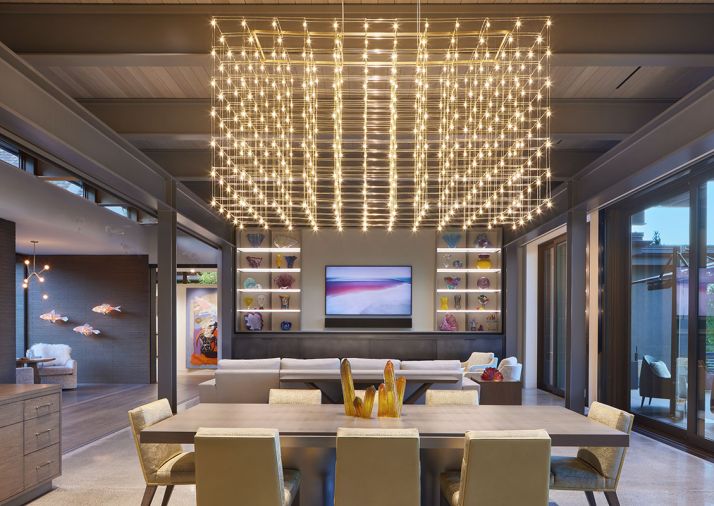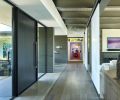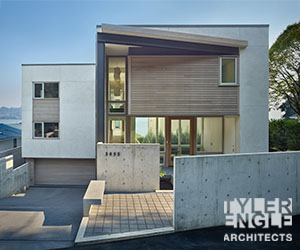Stepping outside her comfort zone, a talented artist of a certain age knew she wanted three things in her new lakeside home: to live surrounded by art amidst a landscape interspersed with gardens and courtyards, and all on a single floor. Other levels were reserved for family or eventually a caregiver, with a lush rooftop garden reachable by elevator.
Schultz Miller project manager David Broder recommended John DeForest of DeForest Architects for the job. “Weaving a large, complex home into the landscape was a wonderful challenge,” recalls DeForest. Which prompted them to begin planting the lakeside garden two years in advance of construction to allow it to mature. An existing home was not only razed by Schultz Miller, but extensively recycled as well.
Her want list envisioned a home that was “modern and spacious with as much view as possible.” DeForest achieved that with a central courtyard with views through to Lake Washington and Mt. Rainier. The pivot entry door is reachable across a bridge over the wrap-around koi pond. Indoors, a cozy seating area overlooking the entry enables her to watch over the koi, while her primary wing, which includes her suite, closet, and office, is reachable through a series of gallery hallways that can be easily closed off to guests by large floor-to-ceiling pocket doors.
She admits she was a little nervous at first about a modern house, but came to feel differently. “I do love it being very modern. Not cold modern. It’s a very warm house.”
“We really pride ourselves,” says DeForest, “on helping clients visualize their design with models, renderings and VR headsets that enable them to walk through the entire house virtually.”
Broder praises DeForest’s use of hands-on block models to explore different ideas quickly and intuitively. The architect’s 3-D computer models also enable Schultz Miller to highlight the structure beneath, as well as the finishes. “That’s very advanced for us,” says Broder, “since this house structure is steel with wood infill, and several different types of finishes, wall, and flooring materials must all be perfectly level and flush, something that’s very difficult to do.”
At first the oxidized steel ceiling beams seemed dark and cold to her. “The black was distracting,” she says and recommended painting them gray to better blend with the hemlock-stained wood ceiling. Likewise, she requested the radiant-heated concrete floors be gray, not brown.
When she was initially concerned about the height of the main floor rooms, Broder noted that the clerestory windows would light up the ceilings and upper roof. “Once the home was completed,” says Broder, “she fell in love with both the height and the expanse of these rooms.”
To bring the outside in, there are fewer walls on which to hang her vast collection of art, which encouraged her to curate her collection to reflect her changing tastes. “I realize I don’t need to keep everything, and the house is forcing me to let go of what I no longer enjoy,” she says.
Trips with longtime friend Karen Skadan of Karen Skadan Design to various design centers from Seattle to Los Angeles helped furnish the home. “We’d sit on every chair to see if it was comfortable. Then Karen would advise me whether one item might go with another. It was all very casual, like window shopping,” she says.
After spotting a spectacular chandelier in Mexico, she found a similar one from Quasar Holland that divides the dining area from the formal living room while adding plenty of sparkle in its wake.
The large primary bath lined with Benjamin Moore Seapearl walls features a courtyard with an outside cascade shower accessible through a triple Weiland lift and slide patio door from Anderson. An unseen wooden screen far right opens the courtyard to a view of the garden.
“As architects,” says DeForest, “you either choose to be ‘The Story,’ or the setting. Seeing how colorful her art is, we built our design around it. Equally important was the high level of craftsmanship and technical expertise that Schultz Miller brought to that effort.”
She totally agrees: “With so much glass around the courtyard,” she says, “you can see the whole house from where I’m sitting. After a year, it’s truly beginning to feel like home.”
PROJECT SOURCES
ARCHITECT
DeForest Architects
deforestarchitects.com
CONTRACTOR
Schultz Miller
schultzmiller.com
LANDSCAPE ARCHITECT
Allworth Design
allworthdesign.com
FIRE FEATURE
Lumacast
lumacast.com
RUGS
Driscoll Robbins Fine Carpets
driscollrobbins.com
SELECT FURNISHINGS
Seattle Design Center
seattledesigncenter.com
Terris Draheim Outdoor
outdoor.terrisdraheim.com
Shoptalk - Tony Giaquinta and Steve Moeller

Tony Giaquinta and Steve Moeller, owners, Schultz Miller schultzmiller.com
Your company focuses on building relationships. Why is this so important to you?
Steve: The house build is fun, but it is building long-term relationships that is most rewarding. The relationship transcends a single project, allowing us to help clients through different phases and needs in life.
Tony: This is the crux of who we are as a company. It applies to architects, designers, subcontractors, employees and clients. I enjoy connecting with people on a personal level and getting to know who they are outside of work.
You’ve been successful for over 40 years. What is the secret to your success?
We have great people, we’re dedicated to quality craftsmanship, and we’re team players. But, above all, we’re open and honest, without exception. We’ve never had a lien placed on a job, never been sued, and never been in litigation of any kind. That’s not as common in construction as it should be.
What is the advantage of clients working with a large company like yours?
Steve: We have the benefit of being able to add resources to a project in a pinch—and there is always a pinch.
Tony: We have decades of experience, and we tap into that experience daily. On the flip side, when you work with us, your project manager and superintendent are like your own personal builder.
You talk about building for the long term. What does this mean to you and your company?
We look at this in several ways, in terms of the quality of the build itself and who we serve. A large share of our work comes from repeat clients, including multi-generational families with whom we’ve worked for decades.
What are some major takeaways from building high-end custom homes?
Steve: Each project is unique, each team is different, so it never gets old. Love that. We get to work with amazing subcontractors, craftspeople and artisans who are the best at what they do.
Tony: There are always new challenges to meet head on.
What part of the process do you find most rewarding?
The most rewarding part is the people we work with and interact with every day, having a happy client at the end of a project, no matter its size or scope. Providing opportunities for 90 employees and for subcontractors and artisans to do great work, knowing that we’re helping them make a living to support their families.
What does generating creative solutions with a focus on cost control look like for your team?
Creative problem solving is one of the most rewarding aspects of what we do. Being able to understand the intent of a design—and finding ways to meet that intent with the best value is a challenge we embrace. We encourage everyone on the job site to speak up with suggestions for working efficiently and saving costs.
Three words that most appropriately sum up your approach to construction are…
Steve: Honesty, integrity, transparency, teamwork, passion—more than three!
Tony: In addition to Steve’s answer, I’ll add craftsmanship and client service.
What interests outside of work keep you motivated?
Steve: Spending time with my wife and daughters before our three daughters are off living their own lives.
Tony: Most important is spending time with our three sons, two juniors in college, one high school junior. Watching and coaching youth sports is something we enjoy as a family.


















